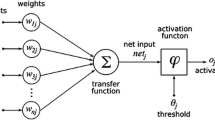Abstract
The main element which justifies the installation of a photovoltaic system is the solar energy potential. Various structures of artificial neural networks (ANNs) are used for predicting the sun location, the global solar radiation (GSR) at horizontal and inclined plans. Real meteorological data have been exploited in order to validate the computation results. The ANNs are also carried out to predict the current-voltage characteristics of the photovoltaic module. It can be concluded that the ANNs effectively predict the behavior of photovoltaic system parameters with good a coefficient of determination.
Similar content being viewed by others
References
Namrata, K., Sharma, S.P., and Seksena, S.B.L., Comparison of different models for estimation of diffuse solar radiation in Jharkhand (India) region, Appl. Sol. Energy, 2015, vol. 51, pp. 219–224.
Namrata, K., Sharma, S.P., and Seksena, S.B.L., Empirical models for the estimation of global solar radiation with sunshine hours on horizontal surface for Jharkhand (India), Appl. Sol. Energy, 2016, vol. 52, pp. 164–172.
Sumithira, T.R. and Kumar, A.N., Prediction of monthly global solar radiation using adaptive neuro fuzzy inference system (ANFIS) technique over the State of Tamilnadu (India): A comparative study, Appl. Sol. Energy, 2012, vol. 48, pp. 140–145.
Oudjana, S. Hamid, Hellal, A., and Mahammed I. Hadj, Neural network based photovoltaic electrical forecasting in south Algeria, Appl. Sol. Energy, 2015, vol. 50, pp. 273–277.
Natarajan, M. and Srinivas, T., Study on solar geometry with tracking of collector, Appl. Sol. Energy, 2015, vol. 51, pp. 274–282.
Yadav, A.K. and Chandel, S.S., Comparative analysis of diffused solar radiation models for optimum tilt angle determination for Indian locations, Appl. Sol. Energy, 2014, vol. 50, pp. 53–59.
Mellit, A., Kalogirou, S.A., Hontoria, L., and Shaari, S., Artificial intelligence techniques for sizing photovoltaic systems: A review, Renew. Sustain. Energy Rev., 2009, vol. 13, pp. 406–419.
Kalogirou, S.A., Artificial intelligence for the modeling and control of combustion processes: a review, Progress Energy Combustion Sci., 2003, vol. 29, pp. 515–566.
Kalogirou, S.A., Artificial neural networks in renewable energy systems applications: A review, Renew. Sustain. Energy Rev., 2001, vol. 5, pp. 373–401.
http://www.energy.gov.dz/francais/.
http://re.jrc.ec.euro-pa.eu/pvgis/apps4/pvest.php.
http://eosweb.larc.nasa.gov/sse/(NASA).
Mellit, N.C.A., PSO based Direct Power Control of grid connected photovoltaic system, 4th International Conference on Electrical Engineering (ICEE), Boumerdes, Algeria, 13–15 Dec., 2015.
Narendra, K.S. and Parthasarathy, K., Identification and Control of Dynamical Systems Using Neural Networks, IEEE Trans. Neural Networks, 1990, vol. 1, pp. 4–27.
Anders, U. and Korn, O., Model selection in neural networks, Neural Networks, 1999, vol. 12, pp. 306–323.
Musavi, W.A.M.T., Chan, K.H., Faris, K.B., and Hummels, D.M., On the training of radial basis function classifiers, Neural Networks, 1992, vol. 5, pp. 587–598.
Haralambos Sarimveis, A.A., Tsekouras, G., and Bafas, G., A Fast and efficient algorithm for training radial basis function neural networks based on a fuzzy partition of the input space, Ind. Eng. Chem. Res., 2002, vol. 41, pp. 751–759.
Miloudi, L. and Acheli, D., Prediction global solar radiation and modeling photovoltaic module based on artificial neural networks, Control, Engineering and Information Technology (CEIT), 3rd International Conference on IEEE Conference Publications, 2015. http://ieeexplore.ieee.org/abstract/document/7233111/.
Koussa, M., Malek, A., and Haddadi, M., Statistical comparison of monthly mean hourly and daily diffuse and global solar irradiation models and a Simulink program development for various Algerian climates, Energy Convers. Manag., 2009, vol. 50, pp. 1227–1235.
Jiang, Y., Computation of monthly mean daily global solar radiation in China using artificial neural networks and comparison with other empirical models, Energy, 2009, vol. 34, pp. 1276–1283.
Stone, R.J., Improved statistical procedure for the evaluation of solar radiation estimation models, Sol. Energy, 1993, vol. 51, pp. 289–291.
Yadav, A.K. and Chandel, S.S., Tilt angle optimization to maximize incident solar radiation: A review, Renew. Sustain. Energy Rev., 2013, vol. 23, pp. 503–513.
Kaushika, N.D., Tomar, R.K., and Kaushik, S.C., Artificial neural network model based on interrelationship of direct, diffuse and global solar radiations, Sol. Energy, 2014, vol. 103, pp. 327–342.
B.Y.H.L. and Jordan, R.C., The interrelationship and characteristic distribution of direct, diffuse and total solar radiation, Sol. Energy, 1960, vol. 4, pp. 89–102.
B.Y.H.L. and Jordan, R.C., The long-term fverage performance of flat-plate solar-energy collectors, Sol. Energy, 1963, vol. 7.
Iqbal, M., Optimum collector slope for residential heating in adverse climates, Sol. Energy, 1978, vol. 22.
Miloudi, L., Acheli, D., and Chaib, A., Solar tracking with photovoltaic panel, Energy Procedia, 2013, vol. 42, pp. 103–112. http://www.sciencedirect.com/science/article/pii/S1876610213017128.
Kacira, M., Simsek, M., Babur, Y., and Demirkol, S., Determining optimum tilt angles and orientations of photovoltaic panels in Sanliurfa, Turkey, Renew. Energy, 2004, vol. 29, pp. 1265–1275.
Equer, B., Energie solaire photovoltaïque, Ellipses Editions Marketing and UNESCO, 1993, vol. 1.
Safari, A. and Mekhilef, S., Simulation and hardware implementation incremental conductance MPPT with direct control method using cuk converter, IEEE Trans. Ind. Electron., 2011, vol. 58, pp. 1154–1161.
Natsheh, E.M., Natsheh, A.R., and Albarbar, A.-H., An automated tool for solar power systems, Appl. Sol. Energy, 2015, vol. 50, pp. 221–227.
Natsheh, E.M., Power generation of solar PVsystems in Palestine, Appl. Sol. Energy, 2016, vol. 52, pp. 193–196.
da Costa, W.T., Fardin, J.F., Machado Neto, L.d.V.B., and Simonetti, D.S.L., Estimation of irradiance and temperature using photovoltaic modules, Sol. Energy, 2014, vol. 110, pp. 132–138.
Author information
Authors and Affiliations
Corresponding author
Additional information
The article is published in the original.
About this article
Cite this article
Miloudi, L., Acheli, D. & Kesraoui, M. Application of artificial neural networks for forecasting photovoltaic system parameters. Appl. Sol. Energy 53, 85–91 (2017). https://doi.org/10.3103/S0003701X17020104
Received:
Published:
Issue Date:
DOI: https://doi.org/10.3103/S0003701X17020104




